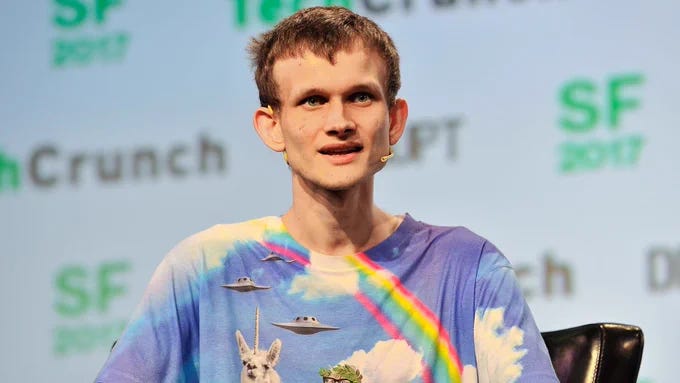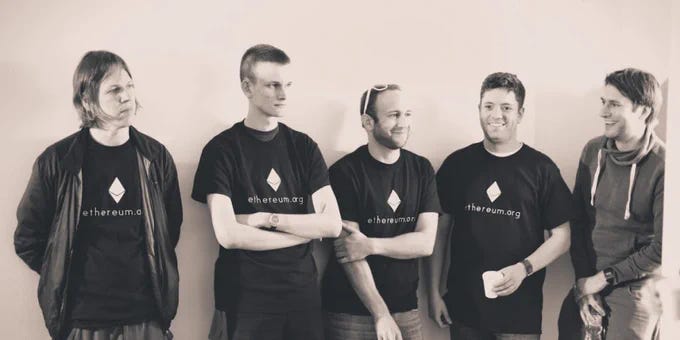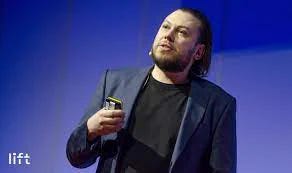How Vitalik Buterin kickstarted the hottest cryptocurrency movement
👋 Hey, it’s Jaime. Welcome to my weekly newsletter where I share how thriving open source projects grow their communities.
If you’re not a subscriber yet, here’s what you have missed from past newsletters:
The Cycles of Bundling and Unbundling to Unleash the Public Sector's Creativity
Why inviting others to steal your ideas can propel you forward
Subscribe to get access to these posts, and all future posts:
In this week’s newsletter, I share how Vitalik Buterin built the movement around Ethereum by joining other communities, growing his reputation, and validating his vision before betting his entire life on it.
Disclaimer: I have grown pretty wary of the crypto world, which has become rife with fraudsters luring people who seek get-rich-quick schemes, but I believe Vitalik Buterin to be sincere in his intent behind Ethereum, and there is a lot to learn from his journey and the principles behind what built the movement.
I originally published a Twitter thread of this essay in March 2023. Since then, I’ve expanded the post. Enjoy.
Read time: 9-ish minutes
In 2014, Vitalik Buterin was introduced by his father to an idea called Bitcoin.
It was the first spark to kickstart the Ethereum movement, which became, at one point, the hottest cryptocurrency worth over $568 billion.
Here's the fascinating story of how he got it started:
The origins
The Ethereum story traces back to the USSR.
Vitalik Buterin's father, Dmitry, was born in 1972 in the Chechen capital of Grozny.
As a child, he was bombarded with incessant propaganda, endured political corruption, and faced shortages of all sorts. This led him to a passion for openness, transparency, and freedom.
"Because of growing up in the [USSR] and seeing the authoritarian regime, its oppression, and bigotry, decentralised systems hold so much promise for us building a better future.”
In Grozny, a neighbour helped him develop an interest in electronics.
This led him to move at age 17 to Moscow to study computer science. After graduation, he married Natalia Ameline, a cybernetics student, and worked as a software engineer and business consultant.
In 1994, Vitalik was born in Moscow.
Three years after his son was born, Dmitry Buterin co-founded the first of his multi-million-dollar businesses. In 1999, they would all move to Canada. Dmitry's entrepreneurial and Soviet heritage would influence the vision behind Ethereum.
In 2011, little after that, the story goes that Vitalik learned about Bitcoin from his father at 17. Then, Bitcoin was only two years old, and he got interested in it after being convinced that the powerful have far too much power.
How to create opportunities
After researching Bitcoin, Buterin wanted to get his hands on some to formally join this new, experimental economy.
But he had neither the cash to buy them nor the computing power necessary to mine bitcoins himself.
Instead of letting this lack of resources stop him, he joined communities where these resources existed and built a platform by continuously contributing.
He searched Bitcoin forums until he found someone willing to pay him in Bitcoin to contribute to a publication called Bitcoin Weekly.
The owner offered five bitcoins (about $3.50 at the time) to anyone who would write an article for him.
This job offer to write articles was the stepping stone for the following stages:
His freely available articles would build his visibility and trust among the Bitcoin communities.
Buterin wrote for the site until it shut down due to a lack of revenue.
Despite the closing of Bitcoin Weekly, Buterin's pieces caught the attention of Mihai Alisie, a Bitcoin enthusiast from Romania.
In late 2011, they co-founded Bitcoin Magazine, one of the most influential crypto publications at the time.
Buterin was laying a solid foundation.
He was:
Building a platform through his side project as a head writer
Taking five advanced courses at the University of Waterloo
Building his skills in cryptography as a part-time research assistant for the cryptographer Ian Goldberg
By writing alone in his bedroom, Buterin established himself as an indispensable authority with a great talent for untangling and explaining the technicalities of blockchain-based cryptocurrencies.
And teaching others also built lots of goodwill and reciprocity towards him.
How to use your skills and platform to share a vision that others are not seeing
Through his writing, Vitalik also shared his vision of what was becoming possible and helped people realise that the Bitcoin blockchain could potentially enable a whole new form of decentralised and autonomous financial services on the blockchain.
Travelling to connect with the early adopters
In 2013, Vitalik Buterin spent six months travelling worldwide, visiting enthusiastic developers.
He gathered the knowledge and contacts for a project that he believed could change the world: Ethereum.
Understanding and articulating the problems you're trying to change
After visiting the people trying to stretch Bitcoin into a more powerful version of itself, Buterin was convinced that everyone was going about this blockchain 2.0 thing completely wrong.
All the projects Buterin found tried to add features by building layers on top of Bitcoin, but they were written in a programming language that limited the complexity of transactions.
New applications were a hack on the system that limited what was possible.
Searching for validating signs before risking everything on a vision
In May of 2013, Buterin made a trip to San Jose, California, for a conference that would change everything.
Bitcoiners had flown in from all around the world for the event.
Cameron and Tyler Winklevoss were there, lending the movement their brawny, celebrity flair and prescribing the community to wait with stealthy patience.
Veterans of the dot-com era drew comparisons between cryptocurrencies and the dawn of the Internet.
Booths showed off new hardware wallets, merchant payment platforms, and Bitcoin ATMs.
And Buterin witnessed it all as a representative of Bitcoin Magazine.
The San Jose event was Buterin’s first glimpse at the living, breathing community cropping up around the cryptocurrency economy.
“That moment crystallised it for me,” he remembers. “It convinced me that this thing’s real, worth taking a risk and jumping into. So I did.”
How to bet at the right time: Find validating signs of an opportunity, then take the risks to go after it
At the end of the semester, Vitalik dropped out of college and started looking for ways to contribute more substantially to the now-boisterous cryptocurrency movement.
Sharing his vision
Later that year, he returned home and published Ethereum's white paper, a technology that looked beyond Bitcoin’s mission of enabling unstoppable, unmediated digital payments and envisioned a platform for autonomous software.
Eventually, he realised that if he wrote a version of Bitcoin that had a Turing-complete programming language, the network could deliver every imaginable digital service right out of the box.
It didn’t even have to stop at financial applications.
You could replicate Facebook, reassemble the stock market, or even build completely digital corporations and run them beyond the jurisdiction of any government entity.
Once placed on a blockchain, they would exist in an environment where software, data, and financial assets interact without friction.
Starting small to invite his community's founding members:
Within a month of arriving home, Buterin had sketched his idea for Ethereum into a whitepaper.
He sent the paper off to 15 of his friends, who then disseminated it further.
When people started sharing it around, he knew he was onto something:
About 30 people reached out to Buterin to talk it over. The reception was more favourable than he had expected.
Among those who stumbled on Buterin’s article was Stephan Tual, a cryptocurrency buff who joined Vitalik’s team:
“I got the whitepaper from Vitalik, and I read it and…I fell on my bump [sic], so to speak, jaw open, thinking, this guy is a genius and I must work for him."
Inviting people to challenge or improve his ideas
Buterin waited for the negative reviews to roll in and for critical flaws to be highlighted, but it never happened.
“When I came up with Ethereum, my first thought was, okay, this thing is too good to be true. I’m going to have five professional cryptographers raining down on me and telling me how stupid I am for not seeing a bunch of very obvious flaws,” Buterin remembers.
“Two weeks later, I was extremely surprised that none of that happened. As it turned out, the core Ethereum idea was good, fundamentally, completely, sound.”
That vision has since become a rallying cry for a whole army of developers.
Sharing the idea with the tribe
A couple of months after publishing the white paper, the founding team flew out to the Bitcoin conference in Miami.
Vitalik described Ethereum on stage, and the audience rewarded him with a standing ovation.
When he stepped away from the podium, he was engulfed by a thicket of Bitcoiners, a mob of people who were convinced that Ethereum might provide the next big fix.
Now the goal is to create a new economy in which anyone can participate on their terms.
Creating ways to participate and building the movement together
In the months that followed the conference, the group of founders that had coalesced decided to fundraise through a crowd-sale of Ether, the native token on the Ethereum network.
Raising funds and formalising the organisation
The founding members raised over 31,000 bitcoins from the crypto community. They used the money to establish the Ethereum Foundation in Switzerland, which oversaw the development of Ethereum’s open-source software.
Building the prototype
The foundation released a beta version of the platform in mid-2015.
All of the Ether promised to early investors was handed out, and developers began using it to play on the platform.
People in the community massively gathered in late 2015 in London to discuss their projects.
In a little over a year, this technology evolved from the dream of one person into an energetic movement that pooled the talents of developers all over the world.
Buterin is no longer just writing his own future; he is building an open-source platform that has inspired people he hasn’t even met to completely rearrange their lives and professional priorities.
While other developers contribute the bulk of Ethereum’s code these days, Buterin, now 28, is focused on the high-level road map for the project.
Today, the Ethereum movement has achieved a lot thanks to its open-source nature and its community.
Its cryptocurrency is worth over $266 billion (in Dec. 2023)
It has created a breadth of use cases for Ethereum (Smart Contracts, dApps, DeFi, NFTs, Stablecoins...)
Whether or not Ethereum vision materialises is still to be seen, and with the recent crashes of the NFT market and the rampant fraud in the crypto markets, it looks harder and harder.
There are still major ecological, wastefulness, and centralisation challenges to tackle.
But what's undeniable is that the movement's birth can inspire other movements to make change happen.
In Summary
Here are the key takeaways you can borrow, modify, and adapt for your own organisation based on Vitalik Buterin’s real-life tactics:
Join communities that seek the change you seek to make
To build your skills and relationships, educate your community
Use your platform to share your vision and ask people to challenge it
Once your vision excites others, go ahead and invite others to build it







